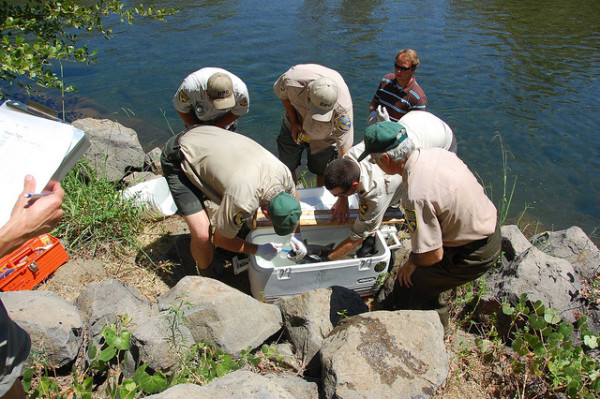Drought’s Devastation For Native Fish

Compelling and haunting story in the L.A. Times this week about the drought’s effects on California’s native fish populations, specifically Chinook salmon.
With the drought four years and counting now, the ramifications of scant rainfall totals, little snowpack and runoff and hot conditions have made survival difficult for salmon heading back from the Pacific into the state’s rivers.
From Times reporter Bettina Boxall:
Spawning winter-run Chinook would never choose to hang out on the outskirts of Redding on a day when the city baked in 111-degree heat. They would prefer to swim in the cold, spring-fed waters of the McCloud and other Sacramento tributaries to the north.
But for about 70 years, those historic spawning grounds have been out of salmon reach, blocked by the towering concrete face of Shasta and the buttresses of its smaller sibling, Keswick Dam.
“This is as far as fish can go on the Sacramento main stem,” fishery biologist Ryan Revnak said as he steered his boat upriver toward Keswick, which regulates flows from Shasta’s hydropower plant.
Revnak, who works for the Pacific States Marine Fisheries Commission, pointed out the gravel beds where the salmon built their nests, called redds. A female, close to death after laying her eggs, hovered in shallow water near the bank. A dead male, his procreative work also done, floated by.
Salmon eggs and emerging fry need cold water to survive. The river temperature shouldn’t top 56 degrees. Last year in the spawning grounds below Keswick, it climbed above 62 degrees. Only 5% of the 2014 brood stock lived.
In the story, Boxall visits the Livingston Stone National Fish Hatchery at Shasta Dam, which has endured heartbreak in terms of loss of salmon.
Last summer, a narrow, rock-rimmed stretch of the blue-green Sacramento River near Redding turned into a mass graveyard for baby salmon. Upstream releases of water from Shasta Dam were so warm, virtually an entire generation of endangered winter-run Chinook was wiped out.
The tanks and egg trays are bathed with circulating water released from the dam. Last summer, hatchery managers had to use chillers to maintain the proper temperature. They may have to do the same this year.
To counter the drought losses, Livingston has ramped up production. The hatchery team is spawning 300 adults this year and come winter will release twice as many juveniles into the Sacramento as it normally does.
But even in good years, only a tiny fraction of those young hatchery salmon survive to adulthood and return to spawn. And if river conditions aren’t right, their offspring will perish.
Facing that grim scenario, Livingston last year established a captive brood stock, which the hatchery will raise for the entire three-year life cycle of the fish. If worse comes to worst, it will function as a fall-back population. “You can’t give up trying,” said Assistant Hatchery Manager John Rueth.
In the meantime, he added, “All of us keep praying for this massive El Niño.”
That El Niño scenario, which unfortunately could also create a whole new set of problems in the state (not to mention not even reverse the curse of this wretched drought), may be a salmon’s sole Christmas wish list this holiday season.



